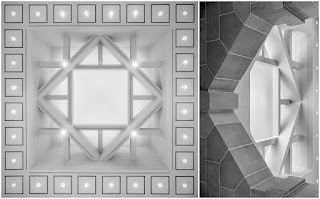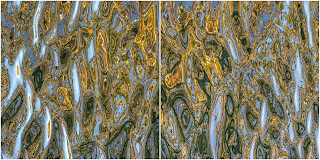Thursday, January 16, 2025
Pattern of Information
Friday, December 27, 2024
Entanglement
- Karen Barad (1956 - )
Meeting the Universe Halfway
Thursday, December 05, 2024
Euclidean Dimensions
- Fyodor Dostoyevsky (1821 - 1881)
Brothers Karamazov
Thursday, November 09, 2023
Observer-Centric Virtualities
Monday, November 06, 2023
Visual Echoes
make your heartbeat match
the beat of the universe, to
match your nature with Nature."
- Joseph Campbell (1904 - 1987)
Sunday, September 17, 2023
Mereological Investigations
partly abstract parts—are
at the bottom of everything.
They are most fundamental
in our conceptual system.
Monday, September 11, 2023
Fox-like Hedgehogian Photography
- Isaiah Berlin (1909 - 1997)
The Hedgehog and the Fox
Whenever I am on "vacation" - such as when my family and I recently visited Iceland - I instinctively recall Isaiah Berlin's well-known essay, "The Hedgehog and the Fox." The essay - a set of musings about Leo Tolstoy, history and human psychology - is woven around an aphorism attributed to Archilochus: "The fox knows many things, but the hedgehog knows one big thing." Berlin divides the world into two different kinds of thinkers. Some, like Aristotle and Shakespeare, are pluralists - or "foxes" - and cast a wide net to get to know as many things as possible; others, like Plato and Dostoyevsky, are monists - or "hedgehogs" - and strive to know one thing as deeply as they can.
So, what does this have to do with photography? Substitute "style (or manner) of composition" for "mode of thinking" to get an inkling of the admittedly imprecise analogy I will now leverage to illustrate the inevitable image-making process I seem to follow during "family vacations." Soon after I arrive at a destination (but excluding the first few days, during which - as a rule - I seem utterly incapable of capturing anything more meaningful than instantly forgettable "touristy" snapshots of something that simply catches my eye), I am drawn exclusively to the "big picture," literally scanning the horizon for sweeping views and landscapes. In other words, I typically approach an "unknown land" like a fox, running from place to place, aware of my larger surroundings, but constantly sniffing, looking, anticipating other places to visit; never resting too long in any one spot. This initial stage of my creative process consists not just of having a loose penchant to search for "Wagnerian landscapes," but is indicative of a deeply entrenched - myopic - focus on "big picture" scenery during which I seem strangely incapable of even seeing anything else. Of course, and for obvious reasons, this "creative insight" is hardly surprising. Iceland's mountains, volcanoes, and glaciers all beckon - demand - your attention even before your plane lands!
But something interesting inevitably happens after a few days go by in a new place. I transform into a "fox-like" hedgehog. While I still scurry around from place to place like a fox (remember, these are vacations I am writing about, so there are usually plenty of sights to see 😊, my eye and camera become deeply drawn to smaller, quieter, vistas that speak more of universal moods and feelings than capturing documentarian-like images of "objects" in a given place. Concomitantly, my compositions transition from images that superficially depict obviously Icelandic scenery (i.e., images that explicitly encode and/or communicate the states-of-being of "multitudinous things" as my eyes saw them "out there" in Iceland), to photographs that implicitly communicate my own state-of-mind (i.e., images that reveal how "big picture" Icelandic vistas transform my inner "I").
Sometimes, rarely, I manage to do both, as in the diptych above. The left big-picture image "obviously" depicts uniquely Icelandic rocky forms (which may be easily confirmed by spending a few moments with Google maps), while the one on the right is at least plausibly Icelandic, given its volcanic appearance, but could have been captured anywhere as I scurried to-and-fro in fox-like fashion. Taken as a whole, the diptych also perfectly conveys my Zen state, as I was lost in, and mesmerized by, Iceland's gentle moods and rhythms. Notably (and not unexpectedly), after looking over my archive of raw files when we got back home, images like these did not emerge until I was into the second week of our trip.
Tuesday, February 28, 2023
Eternal Energy
eternal energy which
appears as this Universe.
You didn't come into this world;
you came out of it.
Like a wave from the ocean.
So that in a way, when you look
deeply into somebody's eyes,
you're looking deep into yourself,
and the other person is looking
deeply into the same self."
- Alan Watts (1915 - 1973)
Friday, February 24, 2023
Gentle Traces and Imprints
the present never lasts.
Time glides by without a trace.
Who can be wise in this constant flux?
I take each day as its own
sustaining myself until I’m released.
After so much wandering,
I have arrived here—
twenty years seen through a cloud."
- Taigu Ryokan (1758 - 1831)
The Kanshi Poem of Taigu Ryokan
Thursday, February 16, 2023
What's a Photographer to Do Without a 'Real' Camera?
- Chase Jarvis (1971 - )
As I wrote about in my last blog post, my wife and I recently visited our youngest son in college. Since the trip was only for a few days (cross-country, no less: we live in northern Virginia, but our son's college is in California), and our ostensible purpose was to attend "Parent's Day," I reasoned - foolishly, as it turns out - that there would be zero time for "real photography" (meaning: photography with what I call my "real" camera). Note that I intend no disrespect either to my iPhone (which I always have with me) or to anyone who's "real camera" is an iPhone. The iPhone is a great photographic tool and is more than capable of capturing wonderful images! I use this phraseology only to convey a truth of my own reality: if I am without the camera(s) that I am usually armed with when I go on my photo safaris I somehow feel less than whole - disarmed, as it were - photographically speaking (which in hindsight of course is, again, rather foolish). Which is not to say that my "eye" is not constantly searching for something to photograph (even as the brain behind the eye laments not having my "real camera").
The (abstract) triptych above is an assembly of a few miscellaneous "shots" I took with my iPhone while waiting to board one of our planes. A few other "quick grabs" I managed to take during the trip included: (1) a shot of the ceiling at an American Airlines' Admirals Club (the "upside down" view of which I much prefer over the "straight" version) ...
(2) a shot of a chandelier at LAX ...
(3) a series of "fire abstracts" (captured while waiting for our dinner to arrive at a restaurant close to our son's college) ...
Friday, January 27, 2023
Hegelian Dialectics
- Georg Wilhelm Friedrich Hegel (1770 - 1831)
Friday, January 13, 2023
Inviting Childhood's Wonder
- Charles Sherrington (1857 - 1952)
Man on his Nature
Postscript. A much-deserved shout-out to Maria Popova and her extraordinary blog, The Marginalian, from which this quote - and the reference to this book (which I did not know of before, and immediately ordered!) - both come from. Thank you Maria! 😊 A little bit more about the book appears here.
Monday, January 02, 2023
Hibernation
- Steve Jobs (1955 - 2011)
Quoted by Walter Isaacson
Saturday, November 05, 2022
Theory of Emptiness
Tuesday, October 25, 2022
Whirling Light
- J. Guven, J. Hanna and M. Müller,
"Whirling skirts and rotating cones,"
New Journal Of Physics (Nov, 2013)
Postscript. The images in the diptych that I took with my iPhone recently (of light reflecting off of cars parked onto the walls of a local garage) reminded me of Rumi's "Whirling Dervishes," about which you can read here and here (in considerably less technical detail than the one you'll find if you follow the link to the physics journal!)
“You are water, whirling water,
Yet still water trapped within,
Come, submerge yourself within us,
We who are the flowing stream.
...
We came whirling out of nothingness,
scattering stars like dust...
The stars made a circle,
and in the middle,
we dance.”
- Rumi (1207 - 1273
Tuesday, October 04, 2022
Sameness and Novelty
- Alfred North Whitehead (1861 - 1947)
Sunday, October 02, 2022
One Side of a Mirror
"There are two worlds. The world you understand and the world you don’t. These worlds exist side by side, sometimes only centimeters apart, and the great majority of people spend their entire lives in one without being aware of the other. It’s like living in one side of a mirror: you think there is nothing on the other side until one day a switch is thrown and suddenly the mirror is transparent. You see the other side."
Saturday, October 01, 2022
Perceptive Play
- David Bohm (1917 - 1992)
Science, Order and Creativity
Friday, September 30, 2022
Subjective Wholes
Thursday, September 29, 2022
Relation Between Observer and Thing
- W. Ross Ashby (1903 - 1972)



























